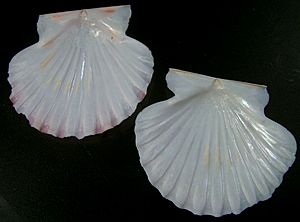Annachlamys flabellata facts for kids
Quick facts for kids Annachlamys flabellata |
|
|---|---|
 |
|
| Two empty valves of Annachlamys flabellata | |
| Scientific classification | |
| Genus: |
Annachlamys
|
| Species: |
flabellata
|
| Synonyms | |
|
|
Annachlamys flabellata is a type of scallop. It is a marine bivalve mollusc, which means it's a sea creature with two shells. This scallop belongs to the family called Pectinidae. You can find it in the shallower parts of the ocean, near the continental shelf, mostly north of Australia.
Contents
What Does the Annachlamys flabellata Scallop Look Like?
Annachlamys flabellata scallops usually grow to be about 6 to 10 centimeters (2.4 to 3.9 inches) long. Their shells are not exactly the same size and are a bit flat. The right shell is rounder and sticks out more than the left one.
Shell Shape and Features
The scallop's overall shape is round. It has two wide "ears" (called auricles) that stick out on either side of the hinge. The hinge line is straight and lines up perfectly with these "ears."
Shell Ribs and Colors
Each shell has 18 to 20 wide ridges, also known as ribs. These ribs are more noticeable on the right shell. The shells also have rings that show how they grew, similar to tree rings. Some or all of the ribs on the left shell can be pink, orange, or purple. The right shell is usually all white. The spaces between the ribs are narrower than in a similar scallop species, Annachlamys reevei. Inside the shell, you might see a red tint or a ring of red dots.
Where Does the Annachlamys flabellata Scallop Live?
You can find Annachlamys flabellata scallops on sandy seabeds. They live in the shallower parts of the ocean, up to about 127 meters (417 feet) deep. These scallops are found along the coasts of Western Australia, Northern Territory, Queensland, and New South Wales in Australia. They also live in New Guinea and Indonesia.
How Does the Annachlamys flabellata Scallop Live?
Annachlamys flabellata scallops rest on sandy seabeds, often covered by a thin layer of sand. They are filter feeders. This means they draw water into their shells through a small gap. As water passes through their gills, they filter out tiny food particles, like microscopic algae. At the same time, their gills take in oxygen. The clean water is then pushed back out.
Growth and Reproduction
These scallops become adults when they are about 4.5 centimeters (1.8 inches) long. Interestingly, smaller scallops are usually male, while larger ones are mostly female. However, you can find some small females and some large males too. This is a type of sex change where they start as one gender and can change to another as they grow.
Spawning and Larvae
In places like lagoons in New Caledonia, where the water temperature doesn't change much, these scallops lay their eggs throughout the year. However, they lay the most eggs during the summer months, from November to March. The eggs are fertilized outside the scallop's body. The tiny young, called larvae, then float in the water as part of the zooplankton (tiny animals drifting in the ocean). After a few weeks, these larvae settle down and change into young scallops.
Images for kids


